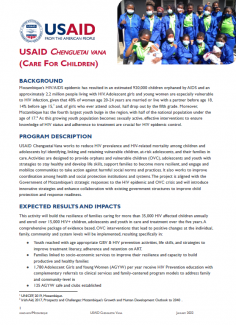BACKGROUND
Mozambique’s HIV/AIDS epidemic has resulted in an estimated 920,000 children orphaned by AIDS and an approximately 2.2 million people living with HIV. Adolescent girls and young women are especially vulnerable to HIV infection, given that 48% of women age 20-24 years are married or live with a partner before age 18, 14% before age 15, and, of girls who ever attend school, half drop out by the fifth grade. Moreover, Mozambique has the fourth largest youth bulge in the region, with half of the national population under the age of 17. As this growing youth population becomes sexually active, effective interventions to ensure knowledge of HIV status and adherence to treatment are crucial for HIV epidemic control.
PROGRAM DESCRIPTION
USAID Chenguetai Vana works to reduce HIV prevalence and HIV-related mortality among children and adolescents byl identifying, linking and retaining vulnerable children, at-risk adolescents, and their families in care. Activities are designed to provide orphans and vulnerable children (OVC), adolescents and youth with strategies to stay healthy and develop life skills, support families to become more resilient, and engage and mobilize communities to take action against harmful social norms and practices. It also works to improve coordination among health and social protection institutions and systems. The project is aligned with the Government of Mozambique’s strategic responses to the HIV epidemic and OVC crisis and will introduce innovative strategies and enhance collaboration with existing government structures to improve child protection and response readiness.
EXPECTED RESULTS AND IMPACTS
This activity will build the resilience of families caring for more than 35,000 HIV affected children annually and enroll over 15,000 HIV+ children, adolescents and youth in care and treatment over the five years. A comprehensive package of evidence based, OVC interventions that lead to positive changes at the individual, family, community and system levels will be implemented, resulting specifically in:
- Youth reached with age appropriate GBV & HIV prevention activities, life skills, and strategies to improve treatment literacy, adherence and retention on ART.
- Families linked to socio-economic services to improve their resilience and capacity to build productive and healthy families
- 1,780 Adolescent Girls and Young Women (AGYW) per year receive HIV Prevention education with complementary referrals to clinical services and family-centered program models to address family and community-level in
- 125 AGYW safe and clubs established
- Community members are engaged to understand the impact of GBV and to take action against harmful and discriminatory social norms, attitudes and practices.
- Community institutions strengthened to respond to violence and shift gender norms; deliver GBV services and support community cadres.
- Systems strengthened to optimize service delivery capacity, response readiness and coordination among health and social protection sectors.

